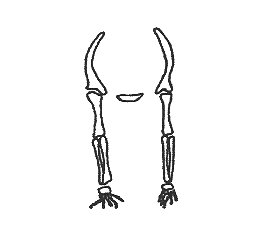| Stem amniotes
| Proto-mammals (used to be referred to as mammal-like reptiles) (e.g., Morganucodon)
| Mammals (e.g., Didelphis) |
| Mandible composed of many bones, including the dentary
| Increase in size of dentary bone, decrease in size of postdentary bones
| Mandible composed of a single bone, the dentary |
| Articulation of mandible with cranium occurs between the articular bone (lower jaw) and the quadrate bone (cranium)
| Articulation varies, and sometimes occurs in two places
| Articulation of mandible with cranium occurs between the dentary bone and the squamosal |
| Sound is conducted from the tympanic membrane to the inner ear via a single bone, the stapes
| Sound is conducted via the stapes, but the articular and quadrate bones also play a role in transmitting sound
| Sound is conducted from the tympanic membrane by a series of three bones: the malleus (called the articular bone in non-mammals), the incus (called the quadrate in non-mammals) and the stapes. They are collectively known as the ossicles. |
| Dentition is homodont
| Dentition is heterodont
| Dentition is heterodont |




